I’ve always been fascinated by the intricate beauty of Society Silk Embroidery. It’s a technique that harks back to the Victorian era when women, with time on their hands, took up needles and thread to create stunning works of art.
This embroidery became popular in the late 19th and early 20th centuries thanks to its detailed designs featuring nature motifs such as flowers, birds, and butterflies.
As I delved deeper into Society Silk Embroidery, I discovered it’s more than just an artistic expression—it’s a reflection of a time and culture where craftsmanship was valued above all else.
The name itself comes from high society ladies who practiced this embroidery, thus giving it an air of elegance and sophistication.
What sets Society Silk apart from other embroidery is its use of silk threads on satin or velvet fabric. The sheen provided by these materials gives each piece a unique glow that can’t be replicated with cotton or synthetic fibers.
With every stitch meticulously placed, Society Silk Embroidery embodies the phrase “the devil is in the detail.”
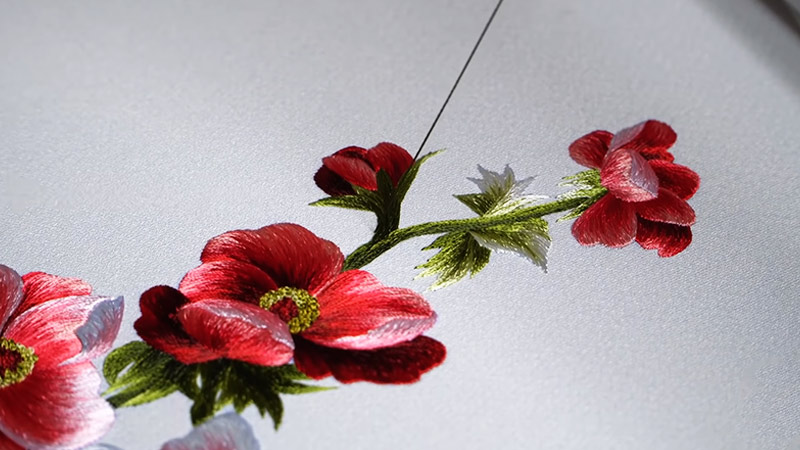
History of Society Silk Embroidery
Society Silk Embroidery, an exquisite form of needlework, emerged in America and Europe in the late 19th century.
Its history is intertwined with the social and economic changes of the time, reflecting both the artistic aspirations of the elite and the financial realities of women from various backgrounds.
Origins and Development
Society Silk Embroidery owes its existence to the availability of fine silk threads produced by manufacturers in the late 19th century. These threads, known for their vibrant colors and sheen, provided the perfect medium for intricate needlework.
Coupled with luxurious fabrics like satin and velvet, they enabled artisans to create stunning pieces of embroidery that quickly gained popularity among the affluent.
Rise to Prominence (1880s – 1920s)
The late 19th and early 20th centuries marked the heyday of Society Silk Embroidery. It became a fashionable pursuit among high society ladies, who showcased their skills through elaborate needlework.
Embroidered pieces adorned clothing, accessories, and household items, serving as status symbols and expressions of artistic refinement.
Socioeconomic Impact
While Society Silk Embroidery was associated with the leisure pursuits of the wealthy, it also significantly impacted women from less privileged backgrounds.
Many women, including those from working-class families, embraced embroidery to supplement their household income.
Some even established small businesses selling their embroidered creations, demonstrating the economic empowerment afforded by this art form.
Challenges and Adaptation (1930s Onwards)
The Great Depression in the 1930s brought significant challenges for Society Silk Embroidery. Economic hardship led to declining demand for luxury goods, including embroidered items.
Furthermore, the outbreak of World War II disrupted silk production and trade, further impacting the availability of materials for embroidery.
Materials and Tools Needed for Society Silk Embroidery
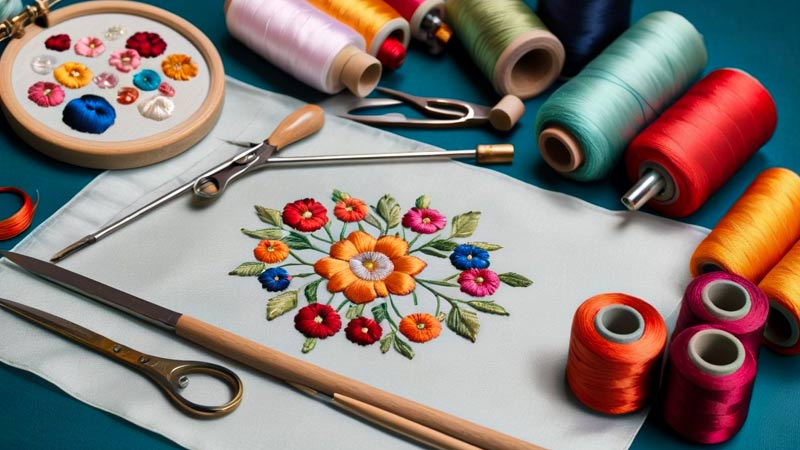
Embarking into Society, Silk Embroidery requires carefully selecting materials and tools to ensure a smooth and enjoyable stitching experience.
Here’s a comprehensive guide to the essentials:
Embroidery Thread
Silk floss takes center stage in Society Silk Embroidery. Renowned for its lustrous sheen and supple texture, silk floss adds a touch of luxury to every stitch.
Popular brands include:
- Au Ver à Soie
- Needlepoint Inc.
- Splendor Silk
Fabric
Light-colored fabrics such as linen or cotton sateen are ideal for showcasing the vibrant hues of silk thread. These materials provide a smooth and stable surface for embroidery work.
Embroidery Hoop
An embroidery hoop is indispensable for securing the fabric tautly, facilitating precise stitching. Hoops come in various sizes and materials (plastic, wood, or metal), allowing stitchers to choose based on their comfort and project requirements.
Needles
Selecting the correct needle is crucial for smooth and efficient stitching. In Society Silk Embroidery, crewel needles are commonly used for their large eye, which eases threading and sharp points, ensuring precise fabric piercing.
Embroidery Stand (Optional but Recommended)
While not essential, an embroidery stand greatly enhances comfort and efficiency by holding the hoop securely, freeing both hands for stitching. This accessory allows for better control and tension management, particularly for intricate designs.
Basic Tools
- Scissors: Essential for trimming threads and cutting fabric.
- Light Source: A good light source is essential for illuminating the workspace, aiding in the clear visibility of small details, and ensuring accurate stitching.
Techniques Used in Society Silk Embroidery

Society Silk Embroidery is characterized by its intricate stitches and meticulous attention to detail. Here are some fundamental techniques used in this art form:
Long and Short Stitch
One of the fundamental techniques in Society Silk Embroidery, the long and short stitch, is prized for its ability to create realistic shading and depth, particularly in floral designs.
By varying the length of stitches, embroiderers can achieve subtle gradations of color, lending a lifelike quality to their work.
Satin Stitch
The satin stitch is employed for filling larger areas with smooth, glossy color, resembling the sheen of satin fabric.
This technique is ideal for highlighting specific elements within a design, creating a contrast between textured areas and smooth surfaces.
French Knots
French knots are tiny, raised knots that add texture and dimension to embroidery pieces. They are versatile and can simulate various details, such as flower centers, animal eyes, or fine stippling.
French knots contribute to the overall richness and intricacy of Society Silk Embroidery.
Color Blending
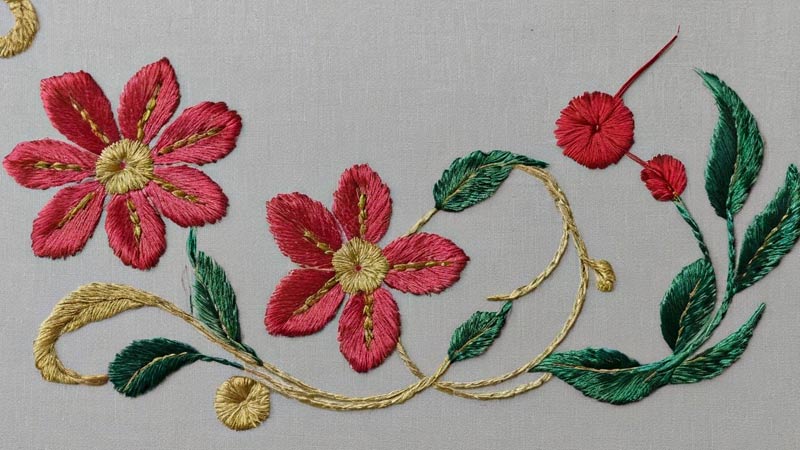
Color blending is essential for achieving nuanced and realistic effects in Society Silk Embroidery. By layering multiple shades of one color, embroiderers can create smooth transitions and subtle variations in hue, mimicking the natural interplay of light and shadow.
Combination Techniques
Experienced embroiderers often employ a combination of techniques to enhance the visual impact of their work.
For example, long and short stitches may be interspersed with satin stitches to create depth and texture, while French knots add intricate details to specific areas of the design.
Personalization and Innovation
While these techniques form the foundation of Society Silk Embroidery, individual artists may develop their unique methods and approaches.
Experimentation and innovation are encouraged, allowing embroiderers to push the boundaries of traditional techniques and create truly distinctive works of art.
Popular Designs in Society Silk Embroidery
Society Silk Embroidery boasts various popular designs that have captivated enthusiasts for generations. These designs encompass a variety of themes, from nature-inspired motifs to geometric patterns and personalized touches.
Here are some of the most beloved designs in Society Silk Embroidery:
Floral Motifs
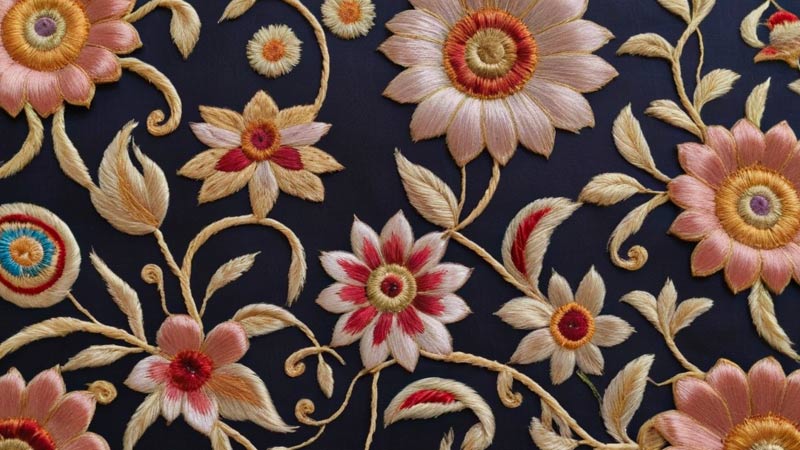
Flowers reign supreme in Society Silk Embroidery, symbolizing beauty, elegance, and sentimentality. Popular floral motifs include roses, lilies, forget-me-nots, and violets, each imbued with cultural and symbolic significance.
These blossoming beauties are celebrated for their vibrant colors and intricate details, making them a perennial favorite among embroiderers.
Geometric Patterns
Geometric patterns lend a sense of sophistication and symmetry to Society Silk Embroidery pieces. Circles, squares, diamonds, and intricate borders often adorn tablecloths, cushion covers, and other household items.
The precise arrangement of shapes creates visually striking compositions that showcase the embroiderer’s skill and attention to detail.
Animals and Birds
Incorporating animals and birds into Society Silk Embroidery designs bring scenes from nature to life. Graceful swans gliding amidst reeds, majestic peacocks displaying their iridescent plumage, and delicate songbirds perched on branches are just a few examples of the wildlife depicted in embroidery.
These motifs add movement and vitality to the fabric, capturing the beauty and wonder of the natural world.
Monograms
Personalization is a hallmark of Society Silk Embroidery, with monograms offering a touch of exclusivity to embroidered pieces.
Stitching one’s initials onto handkerchiefs, towels, or linens adds a bespoke element that is both timeless and elegant. Monograms allow embroiderers to infuse their creations with a sense of individuality and identity, making each piece unique.
Narrative Embroidery
Beyond traditional motifs, Society Silk Embroidery also encompasses narrative themes that tell stories and evoke emotions.
Scenes of rural life, romantic landscapes, and historical events are depicted with intricate stitches and rich colors, inviting viewers to immerse themselves in the narrative woven into the fabric.
How Do You Start Your Society Silk Embroidery Project?
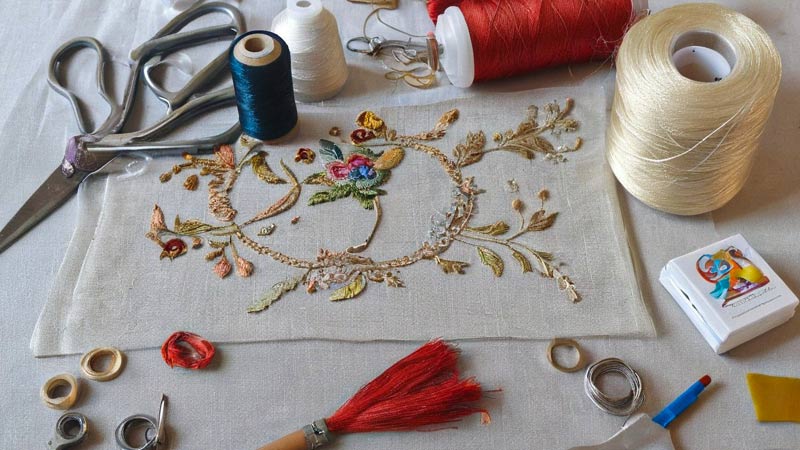
Embarking on a Society Silk Embroidery project is an exciting journey into intricate needlework. Here’s a step-by-step guide to help you get started:
Gather Your Materials
Collect the essential supplies for your project:
- A piece of silk fabric (preferably natural)
- Fine embroidery needles
- High-quality silk threads in various colors
- An embroidery hoop to hold the fabric taut while stitching
Choose a Design
Select a design or pattern for your embroidery project. Beginners may opt for simple floral motifs reminiscent of the Victorian era. As you gain confidence and skill, you can explore more intricate designs.
Transfer the Design
Transfer your chosen design onto the silk fabric using a method that suits you best. Beginners often find the tracing paper method straightforward and effective. Alternatively, you can use transfer pencils or water-soluble markers.
Start Stitching
Begin stitching your design using long and short stitches, known as “needle painting.” This technique creates shading and depth, lending a lifelike quality to your embroidery.
Don’t worry if you’re unfamiliar with a wide range of stitches; focus on mastering the basics and building your skills over time.
Practice Patience and Perseverance
Remember that practice makes perfect in embroidery. Be patient with yourself, and don’t be discouraged by any mistakes or imperfections in your work. Even seasoned embroiderers started as beginners and improved with time and practice.
Embrace Creativity
While Society Silk Embroidery has traditions, there’s room for creativity and personal expression.
Feel free to experiment with different colors, stitches, and techniques to make your embroidery project unique and distinctive.
Enjoy the Process
Above all, enjoy creating beautiful embroidery art. Society Silk Embroidery is a meditative and rewarding craft that allows you to express your creativity while connecting with a rich needlework tradition.
Take your time, savor each stitch, and let your imagination soar as you bring your design to life on silk fabric.
Conclusion
I’ve taken you on a journey, unraveling the exquisite world of Society Silk Embroidery. We’ve explored its history, significance, and the unique techniques that set it apart.
As we’ve seen, Society Silk Embroidery is not merely a craft – it’s an art form steeped in tradition and cultural significance. It embodies elegance and sophistication while showcasing the skillful craftsmanship that blossomed during the Victorian era.
Looking at the technical aspect, we delved into various stitches like satin stitch, stem stitch, and French knots. These aren’t simply knots and threads but elements of a language spoken by artisans throughout centuries.
Just think about those intricate patterns! They tell tales of botanical beauty woven in silk threads – roses, violets, irises – each piece a testament to nature’s splendor encapsulated forever on fabric. Isn’t there something truly magical about that?
More importantly, though, Society Silk Embroidery serves as a reminder of how crafts can transcend their utilitarian purpose to become meaningful expressions of culture and identity. It’s so much more than thread on fabric; it’s history unfolding through every stitch.
In this digital age where mass production often overshadows individual creativity, let’s not forget these traditional art forms. They remind us that there’s beauty in patience and precision – values often lost today.
So next time you see an embroidered piece from this era or try embroidering yourself, remember its roots. You’re not just creating or admiring a piece of art but also honoring an age-old tradition that deserves to be cherished for generations.
Leave a Reply